Abstract
Bovine leukemia virus (BLV) is a retrovirus that infects cattle and sheep and may provide a model for studying human leukemia. Cell-mediated immune mechanisms may play a major role in protection against BLV infection. We describe here for the first time the identification of proliferative (CD4) and cytotoxic T-lymphocyte (CD8) epitopes of the gp51 envelope (env) protein of BLV. This protein and a recombinant form expressed by a vaccinia virus construct have been shown to be potential vaccine candidates. A complete series of overlapping peptides, 20 amino acids in length, was prepared to identify epitopes from gp51. These peptides were tested for the ability to elicit peripheral blood lymphocyte proliferation and cytotoxic T-lymphocyte responses in infected and uninfected cattle and sheep. Peptides 51-70 and 61-80 produced a proliferative response in lymphocytes from only uninfected animals (both sheep and cattle), and this was shown by T-cell subset deletion to be a CD4-mediated response. Seven BLV-infected sheep did not show a response to either peptide. Cytotoxic T-lymphocyte activity, however, was associated only with peptides 121-140 and 131-150. In this case, the response was demonstrated to be CD8 dependent and was found only in BLV-infected animals (sheep). Knowledge of the location of these T-cell recognition domains will complement data available on B-cell epitopes in gp51 and may be useful in the design of a subunit vaccine.
Full text
PDF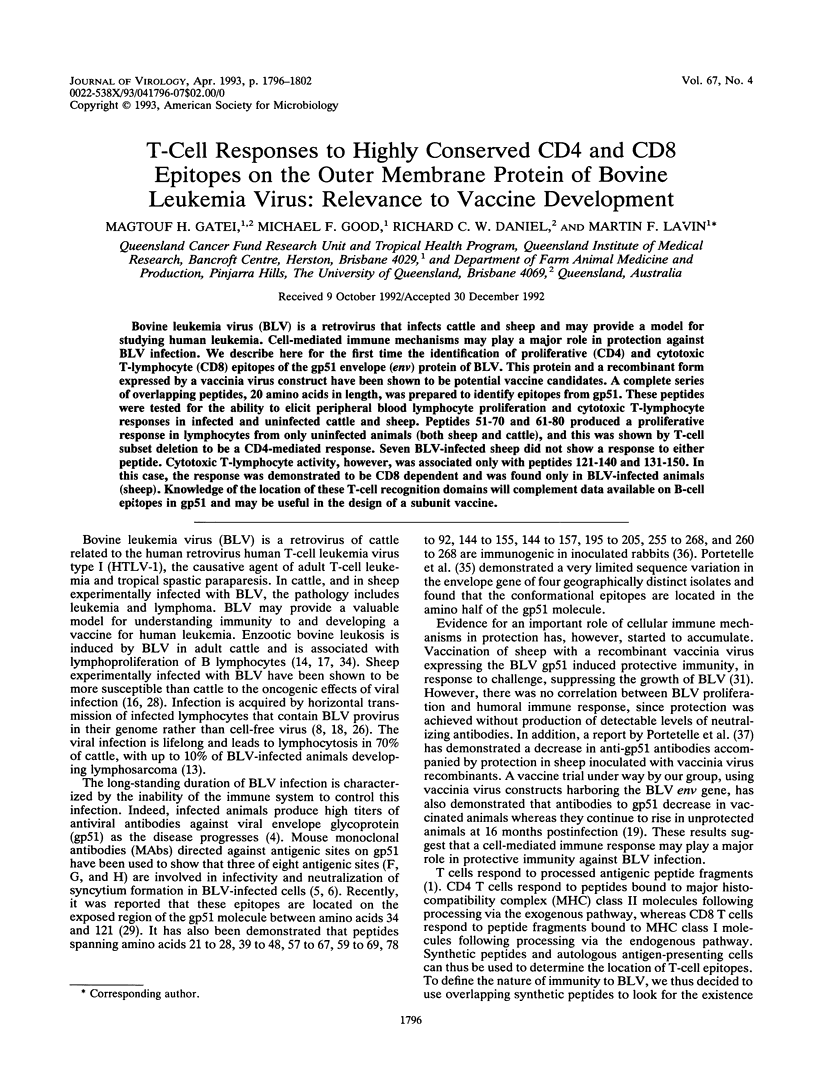
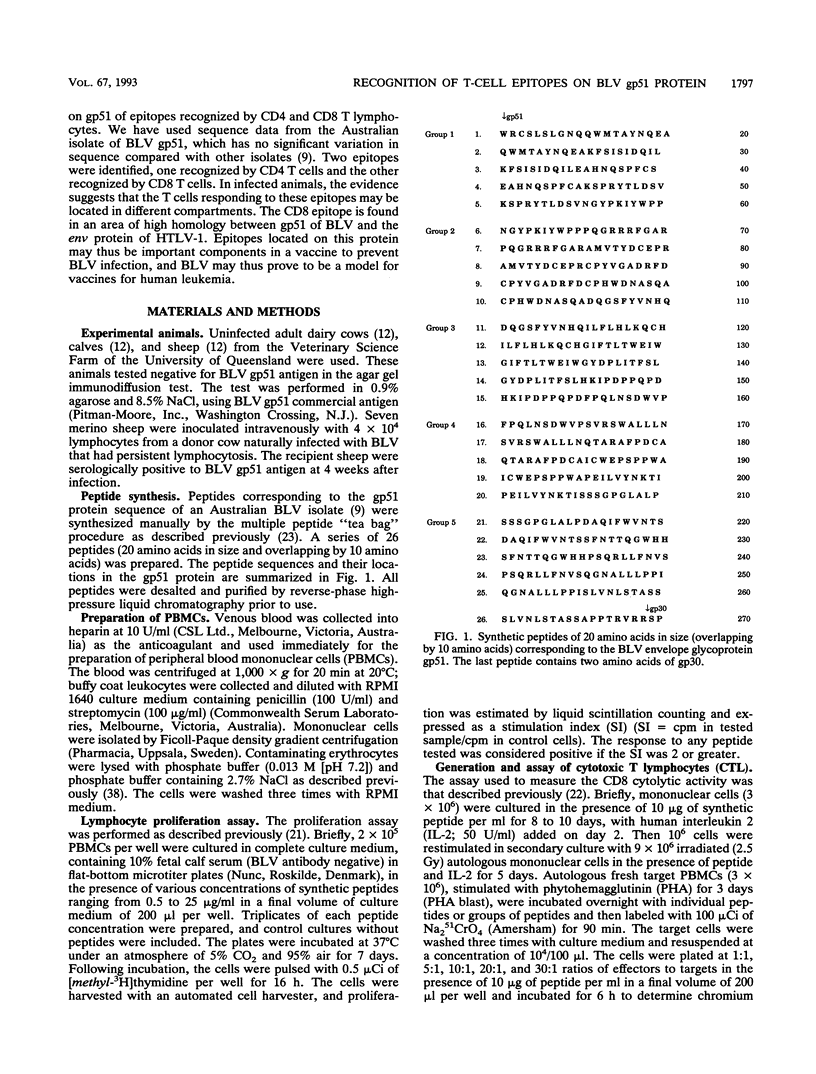
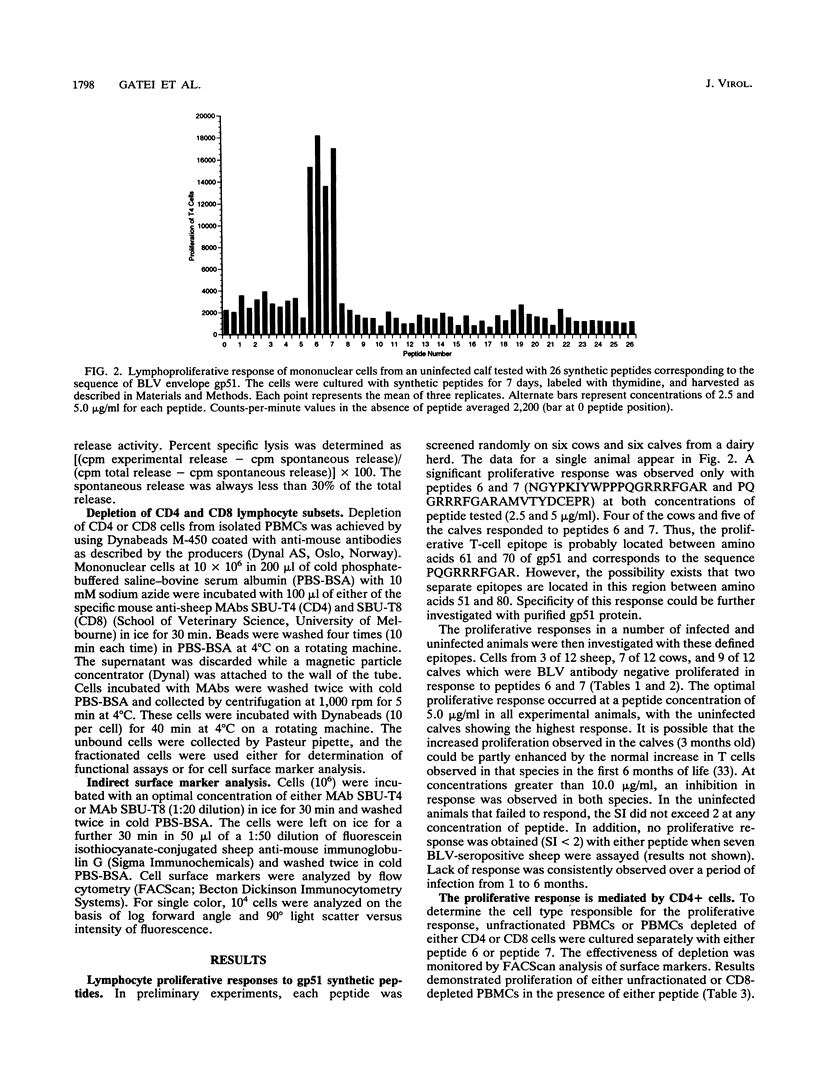
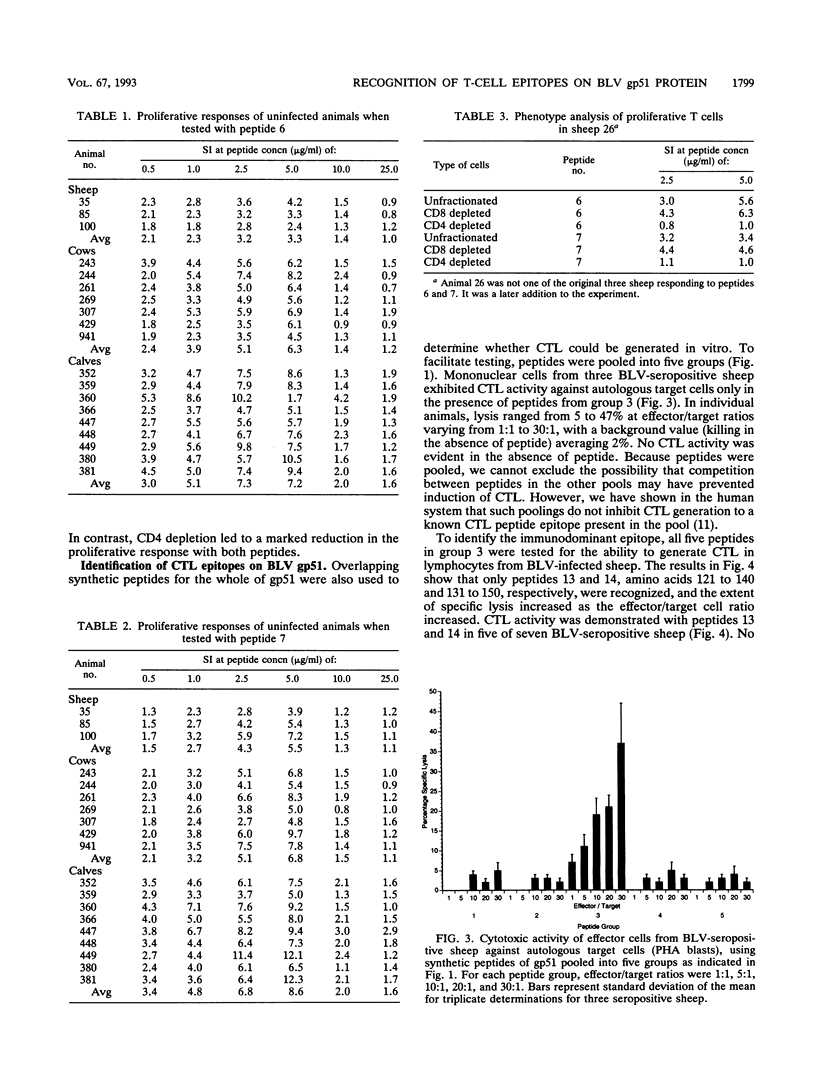
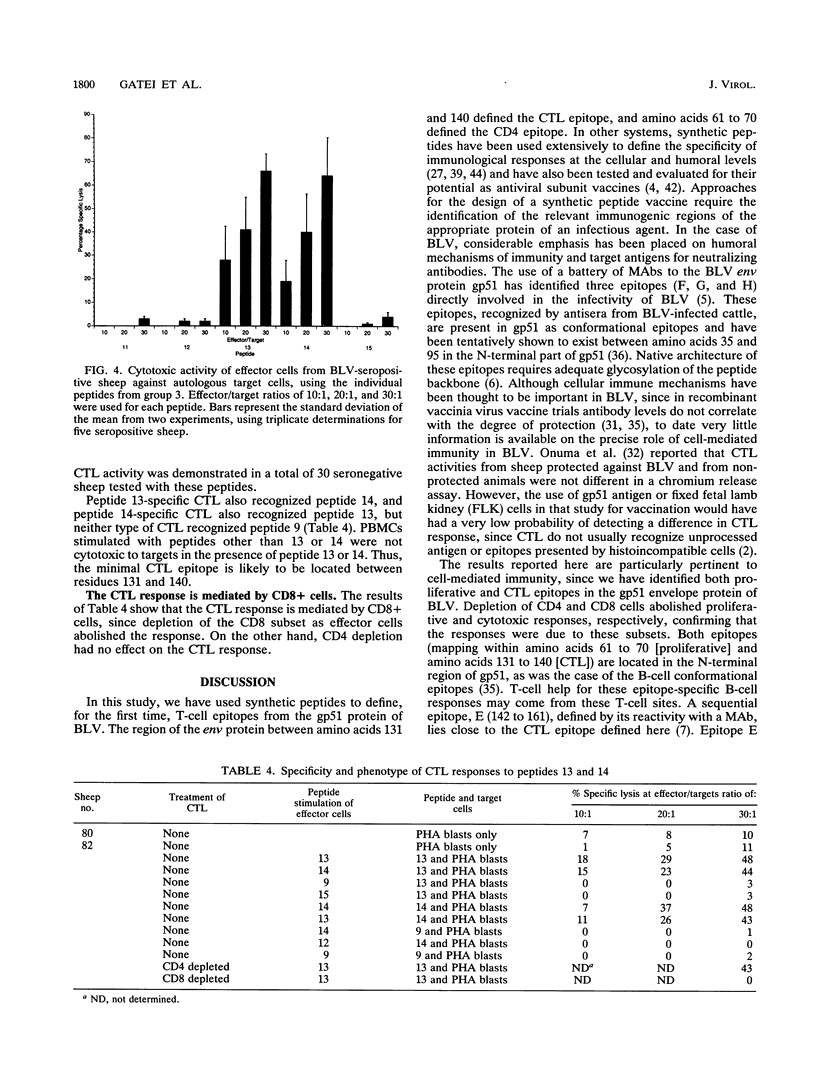
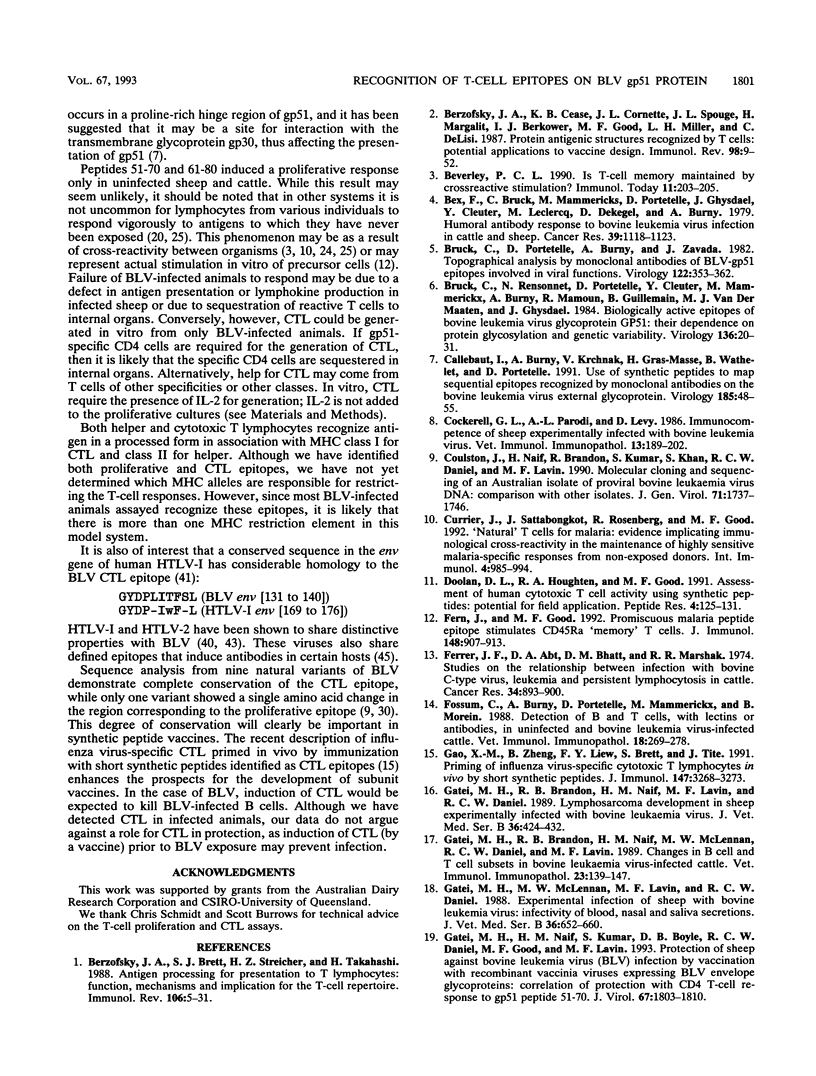
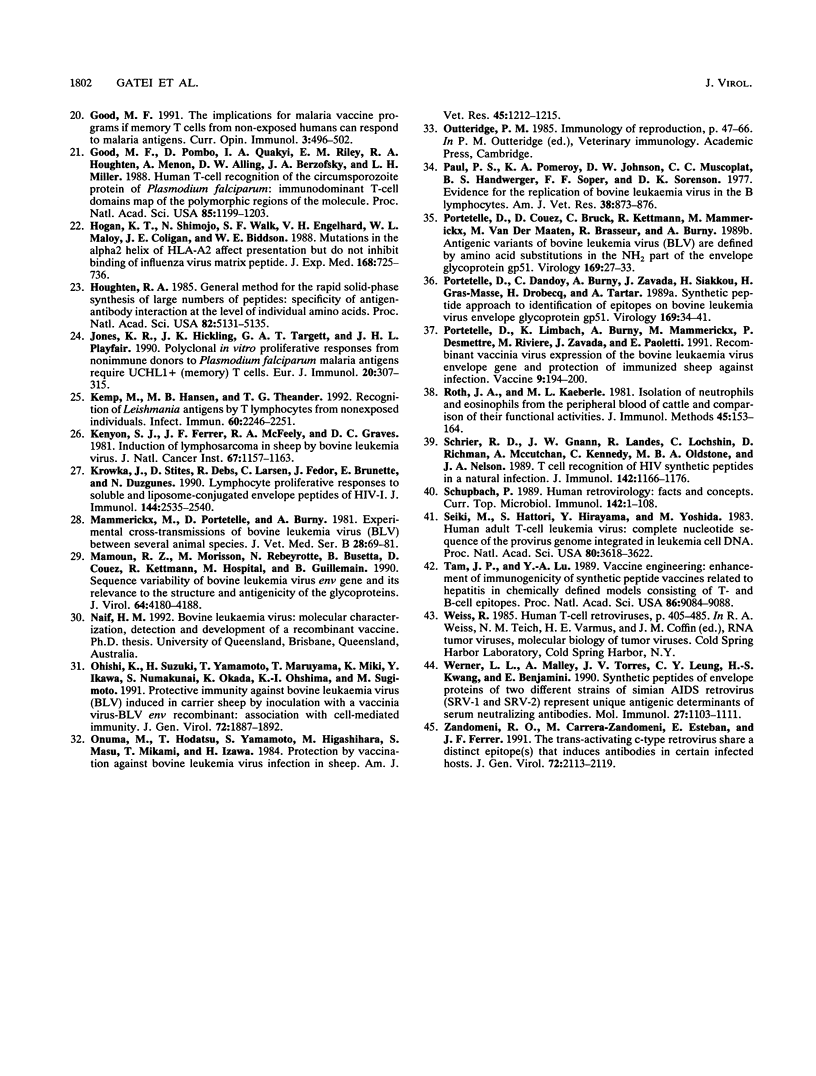
Selected References
These references are in PubMed. This may not be the complete list of references from this article.
- Berzofsky J. A., Brett S. J., Streicher H. Z., Takahashi H. Antigen processing for presentation to T lymphocytes: function, mechanisms, and implications for the T-cell repertoire. Immunol Rev. 1988 Dec;106:5–31. doi: 10.1111/j.1600-065x.1988.tb00771.x. [DOI] [PubMed] [Google Scholar]
- Berzofsky J. A., Cease K. B., Cornette J. L., Spouge J. L., Margalit H., Berkower I. J., Good M. F., Miller L. H., DeLisi C. Protein antigenic structures recognized by T cells: potential applications to vaccine design. Immunol Rev. 1987 Aug;98:9–52. doi: 10.1111/j.1600-065x.1987.tb00518.x. [DOI] [PubMed] [Google Scholar]
- Beverley P. C. Is T-cell memory maintained by crossreactive stimulation? Immunol Today. 1990 Jun;11(6):203–205. doi: 10.1016/0167-5699(90)90083-l. [DOI] [PubMed] [Google Scholar]
- Bex F., Bruck C., Mammerickx M., Portetelle D., Ghysdael J., Cleuter Y., Leclercq M., Dekegel D., Burny A. Humoral antibody response to bovine leukemia virus infection in cattle and sheep. Cancer Res. 1979 Mar;39(3):1118–1123. [PubMed] [Google Scholar]
- Bruck C., Portetelle D., Burny A., Zavada J. Topographical analysis by monoclonal antibodies of BLV-gp51 epitopes involved in viral functions. Virology. 1982 Oct 30;122(2):353–362. doi: 10.1016/0042-6822(82)90235-5. [DOI] [PubMed] [Google Scholar]
- Bruck C., Rensonnet N., Portetelle D., Cleuter Y., Mammerickx M., Burny A., Mamoun R., Guillemain B., van der Maaten M. J., Ghysdael J. Biologically active epitopes of bovine leukemia virus glycoprotein gp51: their dependence on protein glycosylation and genetic variability. Virology. 1984 Jul 15;136(1):20–31. doi: 10.1016/0042-6822(84)90244-7. [DOI] [PubMed] [Google Scholar]
- Callebaut I., Burny A., Krchnák V., Gras-Masse H., Wathelet B., Portetelle D. Use of synthetic peptides to map sequential epitopes recognized by monoclonal antibodies on the bovine leukemia virus external glycoprotein. Virology. 1991 Nov;185(1):48–55. doi: 10.1016/0042-6822(91)90752-w. [DOI] [PubMed] [Google Scholar]
- Cockerell G. L., Parodi A. L., Levy D. Immunocompetence of sheep experimentally infected with bovine leukemia virus. Vet Immunol Immunopathol. 1986 Nov;13(3):189–202. doi: 10.1016/0165-2427(86)90072-3. [DOI] [PubMed] [Google Scholar]
- Coulston J., Naif H., Brandon R., Kumar S., Khan S., Daniel R. C., Lavin M. F. Molecular cloning and sequencing of an Australian isolate of proviral bovine leukaemia virus DNA: comparison with other isolates. J Gen Virol. 1990 Aug;71(Pt 8):1737–1746. doi: 10.1099/0022-1317-71-8-1737. [DOI] [PubMed] [Google Scholar]
- Currier J., Sattabongkot J., Good M. F. 'Natural' T cells responsive to malaria: evidence implicating immunological cross-reactivity in the maintenance of TCR alpha beta+ malaria-specific responses from non-exposed donors. Int Immunol. 1992 Sep;4(9):985–994. doi: 10.1093/intimm/4.9.985. [DOI] [PubMed] [Google Scholar]
- Doolan D. L., Houghten R. A., Good M. F. Assessment of human cytotoxic T cell activity using synthetic peptides: potential for field application. Pept Res. 1991 May-Jun;4(3):125–131. [PubMed] [Google Scholar]
- Fern J., Good M. F. Promiscuous malaria peptide epitope stimulates CD45Ra T cells from peripheral blood of nonexposed donors. J Immunol. 1992 Feb 1;148(3):907–913. [PubMed] [Google Scholar]
- Ferrer J. F., Abt D. A., Bhatt D. M., Marshak R. R. Studies on the relationship between infection with bovine C-type virus, leukemia, and persistent lymphocytosis in cattle. Cancer Res. 1974 Apr;34(4):893–900. [PubMed] [Google Scholar]
- Fossum C., Burny A., Portetelle D., Mammerickx M., Morein B. Detection of B and T cells, with lectins or antibodies, in healthy and bovine leukemia virus-infected cattle. Vet Immunol Immunopathol. 1988 Apr;18(3):269–278. doi: 10.1016/0165-2427(88)90071-2. [DOI] [PubMed] [Google Scholar]
- Gao X. M., Zheng B., Liew F. Y., Brett S., Tite J. Priming of influenza virus-specific cytotoxic T lymphocytes vivo by short synthetic peptides. J Immunol. 1991 Nov 15;147(10):3268–3273. [PubMed] [Google Scholar]
- Gatei M. H., Brandon R. B., Naif H. M., McLennan M. W., Daniel R. C., Lavin M. F. Changes in B cell and T cell subsets in bovine leukaemia virus-infected cattle. Vet Immunol Immunopathol. 1989 Nov 30;23(1-2):139–147. doi: 10.1016/0165-2427(89)90116-5. [DOI] [PubMed] [Google Scholar]
- Gatei M. H., Brandon R., Naif H. M., Lavin M. F., Daniel R. C. Lymphosarcoma development in sheep experimentally infected with bovine leukaemia virus. Zentralbl Veterinarmed B. 1989 Aug;36(6):424–432. doi: 10.1111/j.1439-0450.1989.tb00624.x. [DOI] [PubMed] [Google Scholar]
- Gatei M. H., McLennan M. W., Lavin M. F., Daniel R. C. Experimental infection of sheep with bovine leukemia virus: infectivity of blood, nasal and saliva secretions. Zentralbl Veterinarmed B. 1989 Nov;36(9):652–660. doi: 10.1111/j.1439-0450.1989.tb00658.x. [DOI] [PubMed] [Google Scholar]
- Gatei M. H., Naif H. M., Kumar S., Boyle D. B., Daniel R. C., Good M. F., Lavin M. F. Protection of sheep against bovine leukemia virus (BLV) infection by vaccination with recombinant vaccinia viruses expressing BLV envelope glycoproteins: correlation of protection with CD4 T-cell response to gp51 peptide 51-70. J Virol. 1993 Apr;67(4):1803–1810. doi: 10.1128/jvi.67.4.1803-1810.1993. [DOI] [PMC free article] [PubMed] [Google Scholar]
- Good M. F., Pombo D., Quakyi I. A., Riley E. M., Houghten R. A., Menon A., Alling D. W., Berzofsky J. A., Miller L. H. Human T-cell recognition of the circumsporozoite protein of Plasmodium falciparum: immunodominant T-cell domains map to the polymorphic regions of the molecule. Proc Natl Acad Sci U S A. 1988 Feb;85(4):1199–1203. doi: 10.1073/pnas.85.4.1199. [DOI] [PMC free article] [PubMed] [Google Scholar]
- Good M. F. The implications for malaria vaccine programs if memory T cells from non-exposed humans can respond to malaria antigens. Curr Opin Immunol. 1991 Aug;3(4):496–502. doi: 10.1016/0952-7915(91)90010-x. [DOI] [PubMed] [Google Scholar]
- Hogan K. T., Shimojo N., Walk S. F., Engelhard V. H., Maloy W. L., Coligan J. E., Biddison W. E. Mutations in the alpha 2 helix of HLA-A2 affect presentation but do not inhibit binding of influenza virus matrix peptide. J Exp Med. 1988 Aug 1;168(2):725–736. doi: 10.1084/jem.168.2.725. [DOI] [PMC free article] [PubMed] [Google Scholar]
- Houghten R. A. General method for the rapid solid-phase synthesis of large numbers of peptides: specificity of antigen-antibody interaction at the level of individual amino acids. Proc Natl Acad Sci U S A. 1985 Aug;82(15):5131–5135. doi: 10.1073/pnas.82.15.5131. [DOI] [PMC free article] [PubMed] [Google Scholar]
- Jones K. R., Hickling J. K., Targett G. A., Playfair J. H. Polyclonal in vitro proliferative responses from nonimmune donors to Plasmodium falciparum malaria antigens require UCHL1+ (memory) T cells. Eur J Immunol. 1990 Feb;20(2):307–315. doi: 10.1002/eji.1830200212. [DOI] [PubMed] [Google Scholar]
- Kemp M., Hansen M. B., Theander T. G. Recognition of Leishmania antigens by T lymphocytes from nonexposed individuals. Infect Immun. 1992 Jun;60(6):2246–2251. doi: 10.1128/iai.60.6.2246-2251.1992. [DOI] [PMC free article] [PubMed] [Google Scholar]
- Kenyon S. J., Ferrer J. F., McFeely R. A., Graves D. C. Induction of lymphosarcoma in sheep by bovine leukemia virus. J Natl Cancer Inst. 1981 Nov;67(5):1157–1163. [PubMed] [Google Scholar]
- Krowka J., Stites D., Debs R., Larsen C., Fedor J., Brunette E., Düzgünes N. Lymphocyte proliferative responses to soluble and liposome-conjugated envelope peptides of HIV-1. J Immunol. 1990 Apr 1;144(7):2535–2540. [PubMed] [Google Scholar]
- Mammerickx M., Portetelle D., Burny A. Experimental cross-transmissions of bovine leukemia virus (BLV) between several animal species. Zentralbl Veterinarmed B. 1981;28(1):69–81. doi: 10.1111/j.1439-0450.1981.tb01740.x. [DOI] [PubMed] [Google Scholar]
- Mamoun R. Z., Morisson M., Rebeyrotte N., Busetta B., Couez D., Kettmann R., Hospital M., Guillemain B. Sequence variability of bovine leukemia virus env gene and its relevance to the structure and antigenicity of the glycoproteins. J Virol. 1990 Sep;64(9):4180–4188. doi: 10.1128/jvi.64.9.4180-4188.1990. [DOI] [PMC free article] [PubMed] [Google Scholar]
- Ohishi K., Suzuki H., Yamamoto T., Maruyama T., Miki K., Ikawa Y., Numakunai S., Okada K., Ohshima K., Sugimoto M. Protective immunity against bovine leukaemia virus (BLV) induced in carrier sheep by inoculation with a vaccinia virus-BLV env recombinant: association with cell-mediated immunity. J Gen Virol. 1991 Aug;72(Pt 8):1887–1892. doi: 10.1099/0022-1317-72-8-1887. [DOI] [PubMed] [Google Scholar]
- Onuma M., Hodatsu T., Yamamoto S., Higashihara M., Masu S., Mikami T., Izawa H. Protection by vaccination against bovine leukemia virus infection in sheep. Am J Vet Res. 1984 Jun;45(6):1212–1215. [PubMed] [Google Scholar]
- Paul P. S., Pomeroy K. A., Johnson D. W., Muscoplat C. C., Handwerger B. S., Soper F. F., Sorensen D. K. Evidence for the replication of bovine leukemia virus in the B lymphocytes. Am J Vet Res. 1977 Jun;38(6):873–876. [PubMed] [Google Scholar]
- Portetelle D., Couez D., Bruck C., Kettmann R., Mammerickx M., Van der Maaten M., Brasseur R., Burny A. Antigenic variants of bovine leukemia virus (BLV) are defined by amino acid substitutions in the NH2 part of the envelope glycoprotein gp51. Virology. 1989 Mar;169(1):27–33. doi: 10.1016/0042-6822(89)90037-8. [DOI] [PubMed] [Google Scholar]
- Portetelle D., Dandoy C., Burny A., Zavada J., Siakkou H., Gras-Masse H., Drobecq H., Tartar A. Synthetic peptides approach to identification of epitopes on bovine leukemia virus envelope glycoprotein gp51. Virology. 1989 Mar;169(1):34–41. doi: 10.1016/0042-6822(89)90038-x. [DOI] [PubMed] [Google Scholar]
- Portetelle D., Limbach K., Burny A., Mammerickx M., Desmettre P., Riviere M., Zavada J., Paoletti E. Recombinant vaccinia virus expression of the bovine leukaemia virus envelope gene and protection of immunized sheep against infection. Vaccine. 1991 Mar;9(3):194–200. doi: 10.1016/0264-410x(91)90153-w. [DOI] [PubMed] [Google Scholar]
- Roth J. A., Kaeberle M. L. Isolation of neutrophils and eosinophils from the peripheral blood of cattle and comparison of their functional activities. J Immunol Methods. 1981;45(2):153–164. doi: 10.1016/0022-1759(81)90209-x. [DOI] [PubMed] [Google Scholar]
- Schrier R. D., Gnann J. W., Jr, Landes R., Lockshin C., Richman D., McCutchan A., Kennedy C., Oldstone M. B., Nelson J. A. T cell recognition of HIV synthetic peptides in a natural infection. J Immunol. 1989 Feb 15;142(4):1166–1176. [PubMed] [Google Scholar]
- Schüpbach J. Human retrovirology. Facts and concepts. Curr Top Microbiol Immunol. 1989;142:1–115. [PubMed] [Google Scholar]
- Seiki M., Hattori S., Hirayama Y., Yoshida M. Human adult T-cell leukemia virus: complete nucleotide sequence of the provirus genome integrated in leukemia cell DNA. Proc Natl Acad Sci U S A. 1983 Jun;80(12):3618–3622. doi: 10.1073/pnas.80.12.3618. [DOI] [PMC free article] [PubMed] [Google Scholar]
- Tam J. P., Lu Y. A. Vaccine engineering: enhancement of immunogenicity of synthetic peptide vaccines related to hepatitis in chemically defined models consisting of T- and B-cell epitopes. Proc Natl Acad Sci U S A. 1989 Dec;86(23):9084–9088. doi: 10.1073/pnas.86.23.9084. [DOI] [PMC free article] [PubMed] [Google Scholar]
- Werner L. L., Malley A., Torres J. V., Leung C. Y., Kwang H. S., Benjamini E. Synthetic peptides of envelope proteins of two different strains of simian AIDS retrovirus (SRV-1 and SRV-2) represent unique antigenic determinants for serum neutralizing antibodies. Mol Immunol. 1990 Nov;27(11):1103–1111. doi: 10.1016/0161-5890(90)90098-k. [DOI] [PubMed] [Google Scholar]
- Zandomeni R. O., Carrera-Zandomeni M., Esteban E., Ferrer J. F. The trans-activating C-type retroviruses share a distinct epitope(s) that induces antibodies in certain infected hosts. J Gen Virol. 1991 Sep;72(Pt 9):2113–2119. doi: 10.1099/0022-1317-72-9-2113. [DOI] [PubMed] [Google Scholar]


